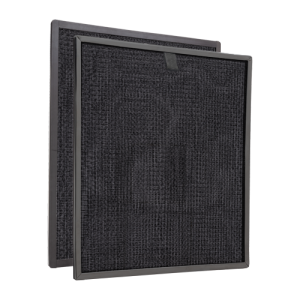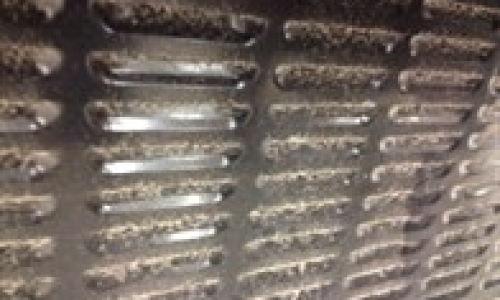As published in Restaurant Facility Business April/May 2015
 It’s every restaurant manager’s nightmare. Picture the lunchtime rush on a hot summer day in New York City, your ice machine has stopped working and customers are lined up for their favorite Frappuccino®. Or your reach-in coolers/freezers stopped working at some point last night, and you arrive at the restaurant to find thirty one flavors of ice cream melted. Food is your business, and food spoilage can mean you are out of business. Every restaurant manager experiences this catastrophe at some point in their career. A major cause of refrigeration inefficiency or failure is poorly maintained, dirty and clogged condenser coils.
It’s every restaurant manager’s nightmare. Picture the lunchtime rush on a hot summer day in New York City, your ice machine has stopped working and customers are lined up for their favorite Frappuccino®. Or your reach-in coolers/freezers stopped working at some point last night, and you arrive at the restaurant to find thirty one flavors of ice cream melted. Food is your business, and food spoilage can mean you are out of business. Every restaurant manager experiences this catastrophe at some point in their career. A major cause of refrigeration inefficiency or failure is poorly maintained, dirty and clogged condenser coils.
Refrigeration systems are designed to artfully and safely store food products within easy reach, and in most cases, house critical refrigeration components inside the base of the unit. These components, including the air intake grill, located at foot traffic level are prone to suck in ground dirt, carpet lint and food ingredients along with necessary fresh air. In refrigeration cases, a dirty clogged condenser coil restricts airflow and makes the system work harder and longer, leading to early failure. In addition, the unit consumes more electricity to maintain optimal food safety temperatures.

Food service equipment can be energy intensive and neglect can be costly. An EPA study reported that as little as 0.042″ of dirt on condensing coils will cause a 21% drop in efficiency and can increase refrigeration energy use by 35%. Another study conducted by Fisher Nickel for the Food Service Technology Center based in California, recently presented their refrigeration unit findings at the RFMA Convention. Their pre-dirty coil and post-clean coil energy monitoring study (KW/h) at three restaurants reported savings of $300-$600/year per unit for glass door merchandisers and solid door refrigerators. The study showed that running a 6 year old, 2-door glass merchandiser with clean coils paid off with a 47% reduction ($600/year) in daily energy use. According to Tom Scottsman, head of design and development for Arctica Showcases, when a refrigeration case fails from lack of air flow, equipment and refrigerant replacement will cost about $500, plus $100/hour for 5-6 hours of labor per unit, without any emergency upcharges.
Refrigeration condensers require regular cleaning, monthly at a minimum. The condenser tends to be front mounted for easier cleaning access. Arctica includes a brush with their display cases, and recommends retail staff brush coils clean every 2 weeks. Preventative maintenance is also recommended quarterly, and costs an average of $100-120 per unit. Depending on the food service environment, cleaning routines can range from careful surface cleaning in the direction of the fins with a good stiff brush (without damaging them) to vacuuming with a shop vac or blowing the dirt off with an air compressor. In areas where grease or oils tend to gather on all surfaces, messy chemical cleanings are required. All of this is usually attempted within the limited confines of clean, busy food preparation areas. Although some newer units are designed with slide-out refrigeration systems, others can require proper tools and complicated removal of a metal grill or louvers.
 The logical and most cost effective preventative solution would be to keep the dirt and grime out of the unit after it’s been thoroughly cleaned and serviced. Top food industry retailers like Starbucks, Costco, Soho and Jewel are finding that they can save time and money by installing a washable electrostatic air intake filter to their new or existing reach-in coolers, ice makers, freezers and refrigerated display cases. Steel framed with a patented magnetic design is one installation option that allows a custom sized filter to stick to the outside of metal air intake louvers; meaning they are accessible from the outside with no need to dismantle the case for frequent coil cleaning. Retail staff can easily see dust build up on the surface of the air filter. Each store or restaurant maintains the filters as part of their daily cleaning schedule by removing, rinsing or vacuuming and reinstalling the eco-friendly filters in minutes. Starbucks NYC regional facilities manager, Bill Miko, found their pastry display cases and ice machines running so much colder with the filter that they were able to adjust the units to lower energy use to accommodate the clean running units. Soho Coffee runs large display cabinets in busy thoroughfares in shopping centers, all of which take a real hammering from foot traffic dust. They are trying air intake filters in their Cheltenham and Bristol UK stores to prevent the chiller mechanisms being over loaded with dust, consequently causing high ticket repairs and excessive energy use. According to Pete Manuel, property director for the company, initial indicators show that these air intake filter screens are proving to be very effective in separating nearly all dust from whirling into the chiller components. An additional benefit is that retail team members are able to remove these filters completely, allowing the dust and dirt to be easily cleaned off away from selling areas and customer traffic.
The logical and most cost effective preventative solution would be to keep the dirt and grime out of the unit after it’s been thoroughly cleaned and serviced. Top food industry retailers like Starbucks, Costco, Soho and Jewel are finding that they can save time and money by installing a washable electrostatic air intake filter to their new or existing reach-in coolers, ice makers, freezers and refrigerated display cases. Steel framed with a patented magnetic design is one installation option that allows a custom sized filter to stick to the outside of metal air intake louvers; meaning they are accessible from the outside with no need to dismantle the case for frequent coil cleaning. Retail staff can easily see dust build up on the surface of the air filter. Each store or restaurant maintains the filters as part of their daily cleaning schedule by removing, rinsing or vacuuming and reinstalling the eco-friendly filters in minutes. Starbucks NYC regional facilities manager, Bill Miko, found their pastry display cases and ice machines running so much colder with the filter that they were able to adjust the units to lower energy use to accommodate the clean running units. Soho Coffee runs large display cabinets in busy thoroughfares in shopping centers, all of which take a real hammering from foot traffic dust. They are trying air intake filters in their Cheltenham and Bristol UK stores to prevent the chiller mechanisms being over loaded with dust, consequently causing high ticket repairs and excessive energy use. According to Pete Manuel, property director for the company, initial indicators show that these air intake filter screens are proving to be very effective in separating nearly all dust from whirling into the chiller components. An additional benefit is that retail team members are able to remove these filters completely, allowing the dust and dirt to be easily cleaned off away from selling areas and customer traffic.
Condenser coil failure is a costly problem to have and lowers food industry profits. Not only is product inventory lost due to food spoilage, but also revenue from the lost sale. Add to that the downtime and expense of having to deal with an expensive repair bill, calling in a service tech and paying emergency rates. Routine maintenance on refrigeration equipment is critical to reduce energy costs, reduce maintenance costs and increase equipment longevity. So keep refrigeration units clean, save time, save money while you relax with mocha drizzle and extra whip on your icy cold frothy beverage.
Clogged Fins

Dusty Intake Louvers


